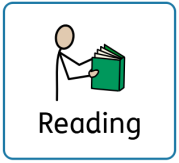A range of strategies will be used to support the development of pre-reading skills, tailored to match the individual developmental needs of learners. These skills may be developed through structured learning opportunities or through exposure within the learning environment.
The strategies include:
Multi-sensory experiences
Learners at an early engagement level may not independently engage with books. To support these learners, we focus on developing early engagement skills, including attention and motivation. Multi-sensory approaches and cause-and-effect activities are used to engage learners, allowing them to access stories and narratives through sensory-based activities. Repetition of stories and activities over time is crucial for learners to begin anticipating, responding consistently to stimuli, and showing enjoyment. Stimuli such as smells, sounds, facial expressions, and objects are introduced, often related to specific topics, to carry meaning for learners.
Shared reading experiences
Learners are exposed to shared reading experiences through various activities. These experiences help learners encounter new vocabulary, become familiar with stories, and develop a preference for reading materials. Shared reading also supports motivation, engagement, and enjoyment. Listening to stories introduces learners to words they might not hear every day and helps them develop an awareness of sentence structure.
Fostering a love for reading
We expose learners to a range of print types and provide access to diverse reading experiences to foster a love for reading, curiosity, and wonder about the world. Learners may have access to designated reading areas within the classroom or sessions in the school library.
Language and communication skills
Communication is key and forms part of our priority curriculum. Introducing learners to a wide range of words increases their vocabulary and understanding of the world. Developing communication skills, language, and vocabulary supports learners in accessing and enjoying reading experiences and begin relating print and stories to their own experiences. Language comprehension is essential for learners to understand what they read, and supporting their knowledge of language can create fluent, passionate, and lifelong readers.
Access to a print rich reading environment
We use a total communication approach, displaying print within the classroom and the wider school. This exposure to various print types helps learners increase their vocabulary and understanding of the purpose and meaning of words and print in both the school and local community. Learners are encouraged to notice and engage with signs, symbols, notices, numbers, and pictures that match their developmental level and understanding.
Listening and attention skills
Developing listening skills is a vital pre-reading skill. Learners are encouraged to focus on tuning into sounds, remembering sounds, and gradually naming them. Before learners can recognise, say, and remember letter-sound correspondences and blend them, they need to closely observe and remember what they see, hear, and say. Learners also need to make sounds and match them to objects, people, or patterns.
Experience of rhyme, rhythm and alliteration
Providing learners with opportunities to hear sounds through songs, poems, and stories supports their ability to isolate sounds and develop phonological awareness.
Pre-reading activities include:
| Strategy |
Example activities |
|
Shared reading experiences
|
|
|
Language and communication skills
|
-
Assisted language displays
-
PODD
-
Communication books
-
Topic based activities
-
School wide: Word of the week
-
Total communication approach
-
Visuals
-
Makaton
-
Intensive interaction
|
|
Access to a print rich reading environment
|
-
Words
-
Symbols
-
Photos
-
Objects
-
Word of the week
-
Signs
-
Local community signs
|
|
Multi-sensory experiences
|
-
Sensory stories
-
Bag books
-
Story sacks
-
Story massage
-
Cause and effect
-
TAC PAC
-
Sensology
|
|
Experience of rhyme, rhythm and alliteration
|
-
Songs
-
Poems
-
Stories
-
Music sessions
|
|
Fostering a love of reading
|
-
Designated reading areas in class
-
Access to books in choosing time
-
School library sessions
-
Access to comics and magazines
-
Story telling sessions
|
|
Listening and attention skills
|
|


